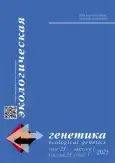The role of the Drosophila genetic collection in the formation of modern scientific research directions and in the educational process at the Department of Genetics and Biotechnology of Saint Petersburg State University
- Authors: Barabanova L.V.1, Grudkova D.M.1, Golubkova E.V.1
-
Affiliations:
- Saint Petersburg State University
- Issue: Vol 23, No 1 (2025)
- Pages: 99-106
- Section: Problems in genetic education
- URL: https://bakhtiniada.ru/ecolgenet/article/view/314453
- DOI: https://doi.org/10.17816/ecogen636544
- ID: 314453
Cite item
Abstract
Genetic analysis, as a fundamental method of genetics, is possible under the obligatory condition of presence of hereditarily different variants of the same features. Success of the analysis depends on the breadth of diversity of hereditary forms available to the researcher. In this regard, creation and maintenance of genetic collections is the first stage of genetic analysis. At present, genetic collections, including Drosophila, have not lost their primary importance even despite the obvious superiority of molecular methods in genetics and shift of research to the level of features characterizing the peculiarities of individual molecules. In many ways, it is the collection material that serves as a starting point in the development of new research directions in modern genetics. In addition, it should be noted that the task of the educational process at the university is to develop the student’s ability to analyze, critically evaluate the results of the experiment, and understand the logic of the experiment. In this regard, the use of genetic collections is an integral part of the educational process, allowing to stimulate the development of the required qualities.
Full Text
##article.viewOnOriginalSite##About the authors
Larisa V. Barabanova
Saint Petersburg State University
Email: l.barabanova@spbu.ru
ORCID iD: 0000-0001-9790-031X
SPIN-code: 3251-2823
Cand. Sci. (Biology)
Russian Federation, Saint PetersburgDaria M. Grudkova
Saint Petersburg State University
Email: st101672@student.spbu.ru
ORCID iD: 0009-0001-0070-0897
SPIN-code: 8220-9716
Russian Federation, Saint Petersburg
Elena V. Golubkova
Saint Petersburg State University
Author for correspondence.
Email: e.golubkova@spbu.ru
ORCID iD: 0000-0002-9528-5760
SPIN-code: 7386-1230
Cand. Sci. (Biology)
Russian Federation, Saint PetersburgReferences
- Vatti KV, Mamon LA, Japaridze LA, Barabanova LV. Comparative study of mutagenesis in individuals of different sexes. Analysis of the frequency of induced translocations. Soviet Genetics. 1979;15(11):1989–1995. (In Russ.)
- Vatti KV, Japaridze LA, Mamon LA. Comparative study of mutability of individuals of different sexes: sex-linked recessive and dominant lethal mutations in the Drosophila melanogaster. Soviet Genetics. 1980;16(8):1389–1396. (In Russ.)
- Iovleva OV. Half-century-long experiment. Studies in the history of biology. 2016;8(3):59–77. EDN: WKXVHL
- Kaidanov LZ. On the principles of genetic analysis of physiological traits. In: Fedorov VK, editor. Actual problems of genetics of behavior. Leningrad: Nauka; 1975. P. 111–118. (In Russ.)
- Belyaeva ES, Pasyukova EG, Gvozdev VA, et al. Transpositions of mobile dispersed genes in Drosophila melanogaster detected by selection. Soviet Genetics. 1981;17:1566–1580. (In Russ.)
- Pasyukova EG, Belyaeva ES, Kogan GL, et al. The study of mobile genetic elements coupled with fitness changes in Drosophila melanogaster. Mol Biol Evol. 1986;3(4):299–312. doi: 10.1093/oxfordjournals.molbev.a040398
- Tikhomirova MM. Modifying influence of extreme temperature on the effect of radiation depending on the adaptation of the organism to heat. Communication II. Analysis of potential chromosome damage in a heat-adapted Drosophila lineage. Soviet Genetics. 1980;16(2):290–297. (In Russ.)
- Tikhomirova MM, Mazur EL, Barabanova LV, Mamon LA. Temperature modification of mutation process and heat shock proteins. Soviet Genetics. 1993;29(2):280–287. (In Russ.)
- Golubkova E, Mamon L, Nikulina A, et al. The evolutionarily conserved family of nuclear export factor (NXF) in Drosophila melanogaster. In: Spindler-Barth M, editor. Drosophila melanogaster: Life cycle, genetics and development. Nova Science Publishers Inc.; 2012. Ch. 3. P. 63–82.
- Ginanova V, Golubkova E, Kliver S, et al. Testis-specific products of the Drosophila melanogaster sbr gene, encoding nuclear export factor 1, are necessary for male fertility. Gene. 2016;577(2):153–160. doi: 10.1016/j.gene.2015.11.030
- Golubkova EV, Markova EG, Markov AV, et al. Dm nxf1/sbr gene affects the formation of meiotic spindle in female Drosophila melanogaster. Chromosome Res. 2009;17(7):833–845. doi: 10.1007/s10577-009-9046-x
- Wilkie GS, Zimyanin V, Kirby R, et al. Small bristles, the Drosophila ortholog of NXF-1, is essential for mRNA export throughout development. RNA. 2001;7(12):1781–1792.
- Mamon LA, Mazur EL, Churkina IV, Barabanova LV. Influence of high temperature on the frequency of non-disjunction and loss of sex chromosomes in Drosophila melanogaster females of the l(1)ts403 line with a defect in the heat shock protein system. Soviet Genetics. 1990;26(3):554–556. (In Russ.)
- Golubkova EV, Atsapkina AA, Mamon LA. Role of the sbr/Dm nxf1 gene in syncytial periods of development in the Drosophila melanogaster. Cell and Tissue Biology. 2015;57(4):294–304. EDN: TODHUB (In Russ.)
- Yakimova AO, Golubkova EV, Mamon LA, Sarantseva SV. Ellipsoid body and medulla defects and locomotion disturbances in sbr (small bristles) mutants of Drosophila melanogaster. Russian Journal of Genetics. 2018;54(6):603–612. EDN: XQKNDV doi: 10.7868/S0016675818060036
Supplementary files







